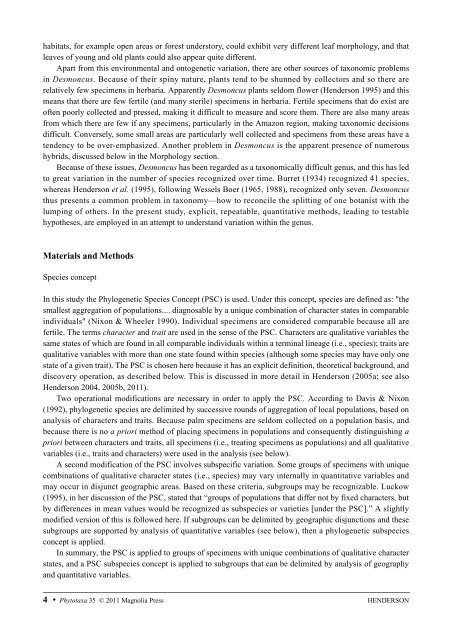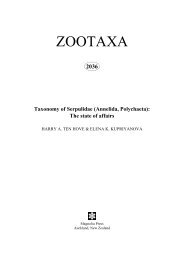You also want an ePaper? Increase the reach of your titles
YUMPU automatically turns print PDFs into web optimized ePapers that Google loves.
habitats, for example open areas or forest understory, could exhibit very different leaf morphology, and that<br />
leaves of young and old plants could also appear quite different.<br />
Apart from this environmental and ontogenetic variation, there are other sources of taxonomic problems<br />
in Desmoncus. Because of their spiny nature, plants tend to be shunned by collectors and so there are<br />
relatively few specimens in herbaria. Apparently Desmoncus plants seldom flower (Henderson 1995) and this<br />
means that there are few fertile (and many sterile) specimens in herbaria. Fertile specimens that do exist are<br />
often poorly collected and pressed, making it difficult to measure and score them. There are also many areas<br />
from which there are few if any specimens, particularly in the Amazon region, making taxonomic decisions<br />
difficult. Conversely, some small areas are particularly well collected and specimens from these areas have a<br />
tendency to be over-emphasized. Another problem in Desmoncus is the apparent presence of numerous<br />
hybrids, discussed below in the Morphology section.<br />
Because of these issues, Desmoncus has been regarded as a taxonomically difficult genus, and this has led<br />
to great variation in the number of species recognized over time. Burret (1934) recognized 41 species,<br />
whereas Henderson et al. (1995), following Wessels Boer (1965, 1988), recognized only seven. Desmoncus<br />
thus presents a common problem in taxonomy—how to reconcile the splitting of one botanist with the<br />
lumping of others. In the present study, explicit, repeatable, quantitative methods, leading to testable<br />
hypotheses, are employed in an attempt to understand variation within the genus.<br />
Materials and Methods<br />
Species concept<br />
In this study the Phylogenetic Species Concept (PSC) is used. Under this concept, species are defined as: "the<br />
smallest aggregation of populations.... diagnosable by a unique combination of character states in comparable<br />
individuals" (Nixon & Wheeler 1990). Individual specimens are considered comparable because all are<br />
fertile. The terms character and trait are used in the sense of the PSC. Characters are qualitative variables the<br />
same states of which are found in all comparable individuals within a terminal lineage (i.e., species); traits are<br />
qualitative variables with more than one state found within species (although some species may have only one<br />
state of a given trait). The PSC is chosen here because it has an explicit definition, theoretical background, and<br />
discovery operation, as described below. This is discussed in more detail in Henderson (2005a; see also<br />
Henderson 2004, 2005b, 2011).<br />
Two operational modifications are necessary in order to apply the PSC. According to Davis & Nixon<br />
(1992), phylogenetic species are delimited by successive rounds of aggregation of local populations, based on<br />
analysis of characters and traits. Because palm specimens are seldom collected on a population basis, and<br />
because there is no a priori method of placing specimens in populations and consequently distinguishing a<br />
priori between characters and traits, all specimens (i.e., treating specimens as populations) and all qualitative<br />
variables (i.e., traits and characters) were used in the analysis (see below).<br />
A second modification of the PSC involves subspecific variation. Some groups of specimens with unique<br />
combinations of qualitative character states (i.e., species) may vary internally in quantitative variables and<br />
may occur in disjunct geographic areas. Based on these criteria, subgroups may be recognizable. Luckow<br />
(1995), in her discussion of the PSC, stated that “groups of populations that differ not by fixed characters, but<br />
by differences in mean values would be recognized as subspecies or varieties [under the PSC].” A slightly<br />
modified version of this is followed here. If subgroups can be delimited by geographic disjunctions and these<br />
subgroups are supported by analysis of quantitative variables (see below), then a phylogenetic subspecies<br />
concept is applied.<br />
In summary, the PSC is applied to groups of specimens with unique combinations of qualitative character<br />
states, and a PSC subspecies concept is applied to subgroups that can be delimited by analysis of geography<br />
and quantitative variables.<br />
4 Phytotaxa 35 © 2011 <strong>Magnolia</strong> <strong>Press</strong><br />
HENDERSON
















